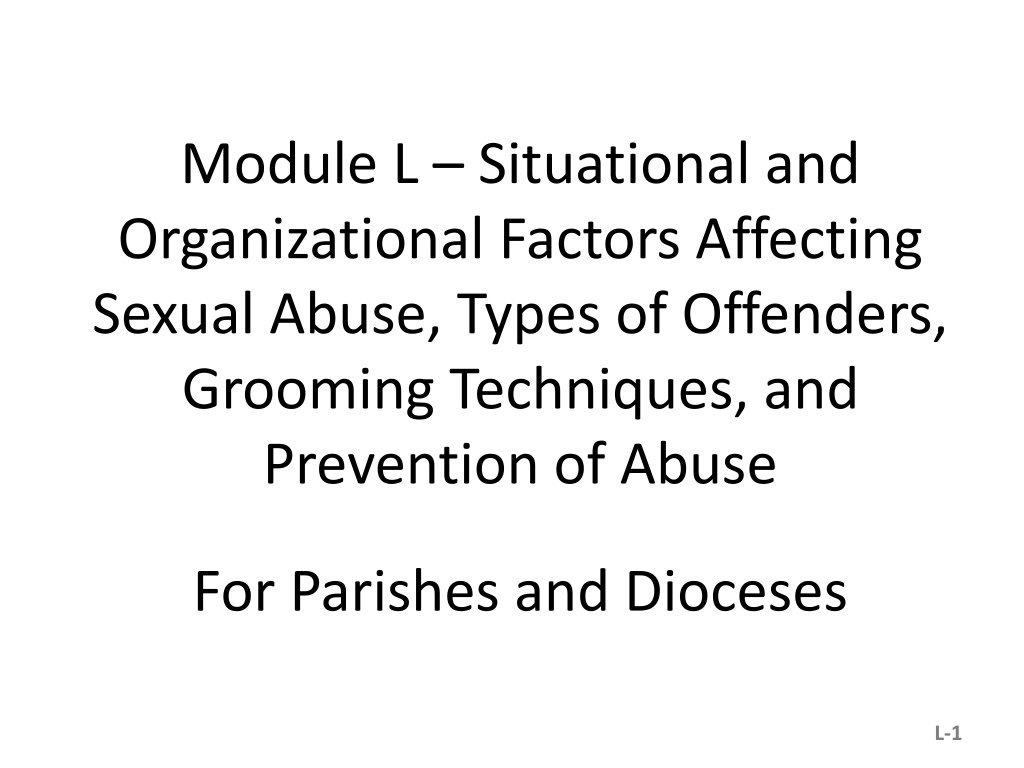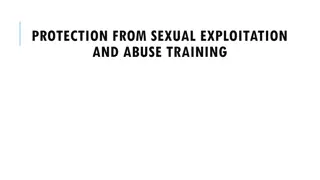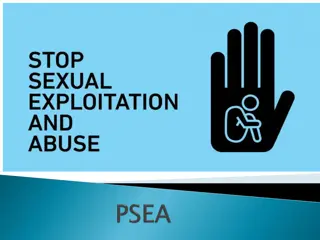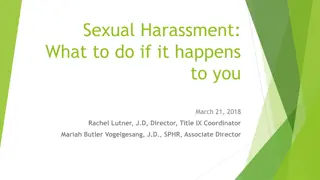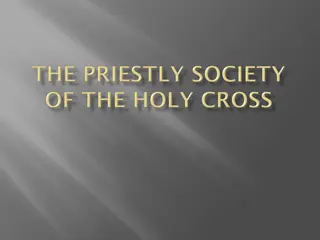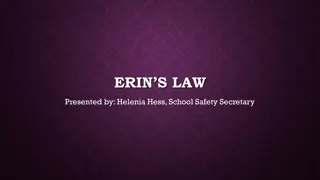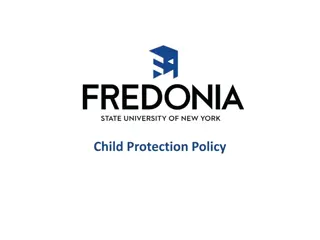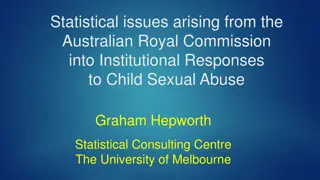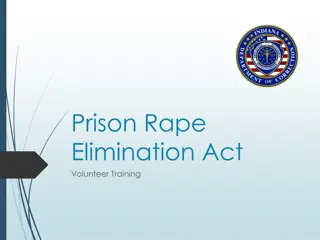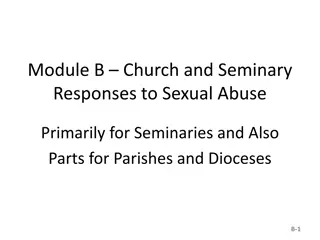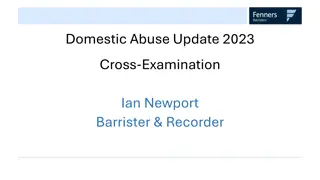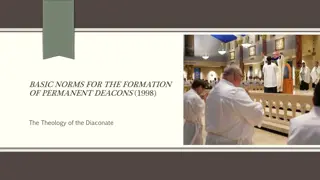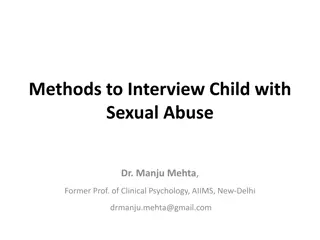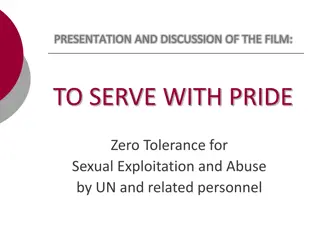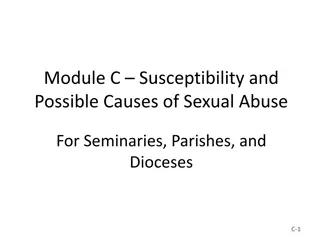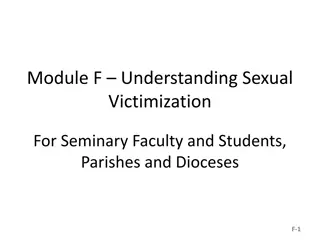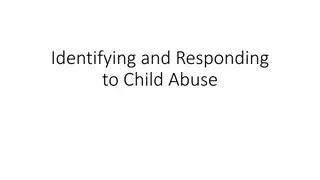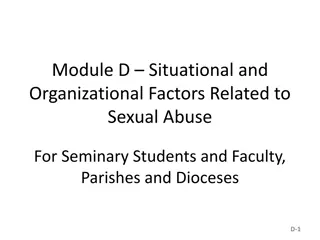Understanding Situational Factors in Sexual Abuse by Catholic Priests
This module delves into the situational and organizational factors influencing sexual abuse of minors by Catholic priests, exploring types of offenders, grooming techniques, and prevention strategies for parishes and dioceses. It highlights key data reports on sexual abuse cases, examines settings and circumstances of abuse, and presents statistics on where victims first encountered their abusers. The information sheds light on the critical aspects surrounding this sensitive issue.
Download Presentation

Please find below an Image/Link to download the presentation.
The content on the website is provided AS IS for your information and personal use only. It may not be sold, licensed, or shared on other websites without obtaining consent from the author. Download presentation by click this link. If you encounter any issues during the download, it is possible that the publisher has removed the file from their server.
E N D
Presentation Transcript
Module L Situational and Organizational Factors Affecting Sexual Abuse, Types of Offenders, Grooming Techniques, and Prevention of Abuse For Parishes and Dioceses L-1
Situational and Organizational Factors Related to Sexual Abuse of Minors by Catholic Priests Types of Offenders, Grooming Techniques, and Prevention L-2
Main Sources of Data Reports presented to the United States Conference of Catholic Bishops by the John Jay College Research Team, The City University of New York The Causes and Context of Sexual Abuse of Minors by Catholic Priests in the United States, 1950-2010, March, 2011 The Nature and Scope of Sexual Abuse of Minors by Catholic Priests and Deacons in the United States, 1950-2002, February 2004 L-3
I. Situational Factors: Settings and Circumstances of Sexual Abuse L-4
Settings Where Victims First Met Priests Who Abused Them Location of First Meeting % Male Victims % Female Victims A. Church/Parish Related 64.8 58.9 B. School/Teacher 15.1 13.6 C. Home of Victim or Relative of Victim 4.9 14.2 D. Other Institutions 7.8 7.3 E. Other 7.1 6.2 Total 99.7 100.2 * % Based on Nature and Scope and victim survey of 7,142 boys and 1,762 girls. L-5
A. Church/Parish Related Location of First Meeting % Male Victims % Female Victims At Mass 33.8 27.1 At an Altar Service/In the Rectory 12.3 10.7 In the Parish 17.5 19.9 Home of Cleric 0.8 0.7 Choir 0.4 0.5 Total 64.8 58.9 L-6
B. Teacher/School Related Location of First Meeting % Male Victims % Female Victims Teacher (up to grade 6) 0.7 1.3 Teacher (grades 7-8) 0.9 1.4 Teacher (grades 9-12) 8.4 4.9 Sunday/Parish School 0.8 0.9 Other School 2.4 4.9 Seminary Faculty/Administrator 1.9 0.2 Total 15.1 13.6 L-7
C. Home of Victim or Relative of Victim Location of First Meeting % Male Victims % Female Victims Home of Victim/Social Function with Victim s Family 4.5 12.7 Cleric is Relative 0.4 1.5 Total 4.9 14.2 L-8
D. Other Institutions Location of First Meeting % Male Victims % Female Victims Boys Club/Youth Recreation 4.9 5.6 Work in Hospital 0.8 0.7 In Jail/Prison/Youth Offender Residence 1.2 0.1 Orphanage 0.9 0.9 Total 7.8 7.3 E. Other Location % Male Victims % Female Victims Other 7.1 6.2 L-9
Physical Locations of Abuse Location of Abuse % Male Victims % Female Victims A. Church/Parish Related 65.8 62.7 B. Residences 59.0 47.0 C. Other Locations 30.5 25.4 Note well: Clergy sexual abuse occurs in multiple settings Most frequently it is in church-related locations A wide range of residential contexts are used Other public and private venues also are exploited L-10
A. Church/Parish Related Locations of Abuse % Male Victims % Female Victims Cleric s Home/Parish Residence 36.3 30.7 In Church 14.2 12.9 In School 8.2 11.4 Cleric s Office 6.2 7.6 Congregate Residence 0.6 0.1 Total 65.8 62.7 L-11
B. Residences Location of Abuse % Male Victims % Female Victims In Victim s Home 10.9 10.4 Vacation House 9.9 5.0 In Other Residences (Friends, Family) 1.0 0.8 21.8 16.2 (Following residences also included in A above.) Cleric s Home/Parish Residence 36.6 30.7 Congregate Residence 0.6 0.1 Total 59.0 47.0 L-12
C. Other Locations Location of Abuse % Male Victims % Female Victims In a Car 8.5 8.4 In a Hotel 7.0 3.6 On Outings Camp, Park, Pool 7.8 5.7 Retreat House 1.2 1.5 In the Hospital 0.7 0.7 Other 5.3 5.5 Total 30.5 25.4 L-13
Circumstances/Timing of Abuse Circumstances/Timing % Male Victims % Female Victims A. Church/Parish Related 27.1 27.8 B. Social Event/Other Recreation 42.2 40.8 C. Other 14.4 16.2 Total 83.7 84.8 * Categories are not mutually exclusive, as victims may have experienced abuse in more than one location. L-14
A. Church/Parish Related Circumstances/Timing % Male Victims % Female Victims Visiting/Working at Cleric s Home/Rectory 13.2 13.1 Church Service (Before, During, After) 8.0 3.4 School Hours 4.2 8.2 During Reconciliation 1.3 2.8 Church Service, Training 0.4 0.3 Total 27.1 27.8 L-15
B. Social Event/Other Recreation Circumstances/Timing % Male Victims % Female Victims During Social Event 17.8 21.9 During Travel 14.0 7.2 Cleric Visited Home of Victim 2.9 7.4 During Sporting Event 4.5 2.5 Outings 3.0 1.8 42.2 40.8 L-16
C. Other Circumstances/Timing % Male Victims % Female Victims During Counseling 6.3 7.1 Hospital Visit 0.1 0.2 During a Retreat 0.8 1.4 Other 7.2 7.5 14.4 16.2 L-17
II. Organizational Factors Relating to Abuse L-18
Priests Primary Duty or Role at Time of Abuse Duty or Role % Male Victims % Female Victims A. Pastoral/Parish Related 77.2 80.2 B. Other Clerical Role 6.7 5.6 C. School/Teaching Role 8.7 5.6 D. Other 7.4 8.6 Total 100.0 100.0 * Based on Nature and Scope victim surveys of 7,864 boys and 1,863 girls. L-19
A. Pastoral/Parish Role Duty or Role % Male Victims % Female Victims Associate Pastor 42.2 42.1 Pastor 25.0 26.0 Resident Priest 8.8 10.9 Saying Mass 1.2 1.2 Total 77.2 80.2 L-20
B. Other Clerical Role Duty or Role % Male Victims % Female Victims Bishop, Vicar, Chancellor, Cardinal 0.4 0.2 Seminarian/Seminary Administration/Faculty 1.9 1.4 School/Institutional Administrator 1.0 1.7 Chaplain 2.8 2.1 Worked in Hospital 0.6 0.2 Total 6.7 5.6 L-21
C. School/Teaching Role Duty or Role % Male Victims % Female Victims Teacher (up to grade 6) 0.2 0.1 Teacher (grades 7-8) 0.3 0.4 Teacher (grades 9-12) 7.2 4.2 Guidance Counselor 0.9 0.6 Catechism Teacher 0.1 0.3 Total 8.7 5.6 L-22
D. Other Duty or Role % Male Victims % Female Victims Boys Club/Recreation 1.6 1.2 Cleric is Relative 0.3 1.0 Other 5.5 6.4 Total 7.4 8.6 L-23
A. The Fixated/Regressed Typology The distinction between fixated and regressed sexual offending exists on a continuum and is not simply a dichotomous distinction Two issues that differentiate the types: The degree to which deviant sexual behavior is entrenched The basis of the psychological needs that lead to abuse L-24
Fixated Offenders: Definition They have persistent, continual, and compulsive attraction exclusively to children from adolescence onward They are usually diagnosed with pedophilia, or recurrent, intense, sexually arousing fantasies of at least six months in duration involving prepubescent children L-25
Regressed Offenders: Definition They usually begin offending in adulthood Their offenses stem from stressors in the environment, which undermine self-esteem and confidence, and from disordered childhood relationships They are not necessarily motivated by sexual needs alone L-26
B. FBI Typologies: Situational Offenders, 1 Type of Offender Situational offenders Characteristics of Offenders Regressed Offenders have poor coping skills, target victims who are easily accessible, abuse children as a substitute for adult relationships Morally Indiscriminate Offenders do not prefer children over adults and tend to use children (or anyone accessible) for their own interest (sexual and otherwise) Sexually Indiscriminate Offenders are mainly interested in sexual experimentation, and abuse children out of boredom Inadequate Offenders are social misfits who are insecure, have low self-esteem, and see relationships with children as their only sexual outlet L-27
FBI Typologies: Preferential Offenders, 2 Type of Offender Preferential offenders Characteristics of Offenders Seductive Offenders court children and give them much affection, love, gifts, and enticements in order to carry on a relationship Fixated Offenders have poor psychosexual development, desire affection from children, and are compulsively attracted to children Sadistic Offenders are aggressive, sexually excited by violence, target stranger victims, and are extremely dangerous L-28
C. Personality Characteristics of Clergy Offenders, 1 Several researchers have concluded that clergy offenders are truly unique in comparison to offenders within the general population. One review of literature maintained that clergy offenders displayed shyness, loneliness, and passivity MMPI scores illustrated the presence of depression, authority concerns, and addiction problems Rorschach results indicated greater affect constriction than normal Offending clergy exhibited the presence of over- controlled hostility more than non-offending clergy L-29
Personality Characteristics of Clergy Offenders, 2 One of the specific clergy studies found that offenders came from backgrounds Characterized by rigidity and dysfunction with themes of abuse Had little insight into these areas Had insufficient training in the issue of transference/counter transference Had virtually no training or education concerning sexual abuse, domestic violence, addictive disease, or healthy professional boundaries, and Failed to appreciate how their history of trauma affected their professional life L-30
Onset of Abuse, 3: Overcoming External Factors that May Prevent Abuse from Occurring Abusers often create opportunities for the abuse to take place, such as socializing and building trust with the victim s family Abusers must overcome the child s resistance to the abuse, which is generally achieved through grooming tactics such as verbal and/or physical coercion, seduction, games, and enticements L-31
C. Grooming Behavior Grooming is a pre-meditated behavior intended to manipulate a potential victim into complying with sexual abuse Examples of various tactics or methods used to entice victims: seduction or manipulation verbal or physical intimidation provision of benefits such as tickets to sporting events, or taking them on trips, money, or other gifts building of personal and family relationships L-32
Grooming 2, Seduction and Testing of a Child This tactic is used when there is a relationship with a child and the child is accustomed to the affectionate expression of the offender The offender gradually extends the affectionate behavior, all the while testing the child s response; if no overt resistance is observed, the sexual abuse continues L-33
Grooming 3, Emotional Manipulation and Verbal Coercion These were the most common tactics used by offenders to groom their victims. Examples: - Doing favors for the victim in exchange for sex - Emotionally blackmailing the victim into compliance - Even though it may appear that there is room for negotiation on the part of the victim, the outcome always favors the offender L-34
Grooming 4, Catching the Victim by Surprise The offender orchestrates a situation to distract the victim or seizes the opportunity to abuse when it occurs A frequent situational opportunity arises when potential victims become altar servers or otherwise serve a role in the church Seizing the opportunity is most common and is usually the result of the offender s frustration from waiting for the right time to initiate contact L-35
Grooming 5, Using Verbal or Physical Force The offender garners victim compliance through use of force The offender either commands the victim to perform sexual acts and/or physically forces the victim to engage in sexual acts This factor is more common among the most serious, repeat offenders L-36
Grooming 6, Disguising Sexual Advances This tactic disguised sexual advances in the context of playing a game. Example: Offender will begin by tickling the victim and gradually progress to fondling While this approach may appear spontaneous, it has been well planned by the offender, yet orchestrated in a rather surreptitious manner L-37
Grooming 7, Using Alcohol and Drugs During the peak years of abuse, the use of alcohol and drugs by abusive priests increased significantly, but only for male victims Why this finding is important: The increase in the use of alcohol and drugs by the abuser is consistent with the increase in the abuse of males The increase in the abuse of males is consistent with the increase in the abuse of minors by priests The use of alcohol and/or drugs by the abuser is a feature of the situational or regressed child abuser, but not of the fixated abuser L-38
Grooming 8, Building Relationships with the Families of Victims Family relationships were built to gain trust Parents of abused children trusted the priests without reservation The children who were abused often accepted the abuse and did not report it for many years This lack of disclosure and concern about reporting the abuse was one reason it was able to persist L-39
Grooming 9, Effects of Grooming over Time Grooming tactics are premeditated and more methodically planned than spontaneous abuse The offender is willing to wait months or even possibly years to accomplish his task Eventually the victim becomes groomed to the point that engaging in sex with the offender is more or less automatic L-40
Five Ways to Prevent Abuse by Implementing Situational Crime Prevention Models 1. Increase the effortit takes for priests to commit acts of abuse Implement mandatory safe environment training to raise awareness among Potential victims Guardians Potential abusers L-41
Five Ways to Prevent Abuse, 2 2. Increase the risksby making it more likely that those who commit acts of abuse will be identified, and once identified, will have more to lose Increase the risk of getting caught by educating potential victims and guardians Enforce the zero tolerance policy for abusers, which makes the risk greater if one is recognized as an abuser Institute periodic evaluation of the performance of priests in dioceses so that questionable behavior will be more likely to be detected and controlled L-42
Five Ways to Prevent Abuse, 3 3. Reduce the rewardsby providing alternate outlets for close bonds with others Lessen the need for priests to develop social bonds with adolescents they are mentoring Increase opportunities for priests to form social friendships and suitable bonds with age-appropriate persons L-43
Five Ways to Prevent Abuse, 4 4. Reduce provocationsby diminishing the factors that may lead priests to abuse, such as stress Provide stress-reduction seminars after transitions into a new parish Require ongoing formation, including opportunities to develop administrative and financial planning skills Make available time for participation in priest support groups to decrease likelihood of isolation and stress L-44
Five Ways to Prevent Abuse, 5 5. Remove excusesthrough education about what types of behavior are and are not appropriate with minors Eliminate, as far as possible, the ability of priests to use techniques of neutralization, whereby they excuse and justify inappropriate behavior Techniques of neutralization often develop over time and after periods of stress or other negative experiences in work and life L-45
Summary of Situational and Organizational Factors, Types of Offenders, Grooming, and Prevention Related to Sexual Abuse of Minors Situational Factors: Settings and Circumstances of Sexual Abuse - Settings Where Victims First Met Priests Who Abused Them, Physical Locations of Abuse, and Circumstances and Timing of Abuse Organizational Factors Related to Abuse - Priests Primary Duty or Role at Time of Abuse Types of Offenders: Fixated, Regressed, Situational, and Preferential Characteristics of Clergy Offenders Grooming Techniques Situational Crime Prevention L-46
Discussion Questions, 1 Taking into account the circumstances and timing that were most common when abuse was perpetrated, what instructions should be given to parishioners, especially parents, and to children about sexual abuse? What safeguards should be implemented in parish settings to reduce the probability of abuse? Considering the settings and locations where abuse took place, what precautions should priests and other church leaders take relative to where they meet young people? What are the major differences between types of sexual offenders? L-47
Discussion Questions, 2 What risk factors particular to clergy might be observed in potential clergy sex offenders? What are the essential ingredients of educational programs that can help prevent sexual abuse? What components of the prevention models are most useful in your situation? How can oversight be enhanced to prevent further sexual abuse? To what extent are recommendations on education of young people, parishioners, and church leaders being implemented? Link to USCCB http://www.usccb.org/issues-and-action/child- and-youth-protection/charter.cfm L- 48
Prepared by: Sister Katarina Schuth, O.S.F., St. Paul Seminary School of Divinity, University of St. Thomas Technical Associate: Catherine Slight Consultants: Dr. Karen Terry and Margaret Smith, John Jay College of Criminal Justice, authors of major studies on sexual abuse for the USCCB; Dr. Mary Gautier, Center for Applied Research in the Apostolate L-49
